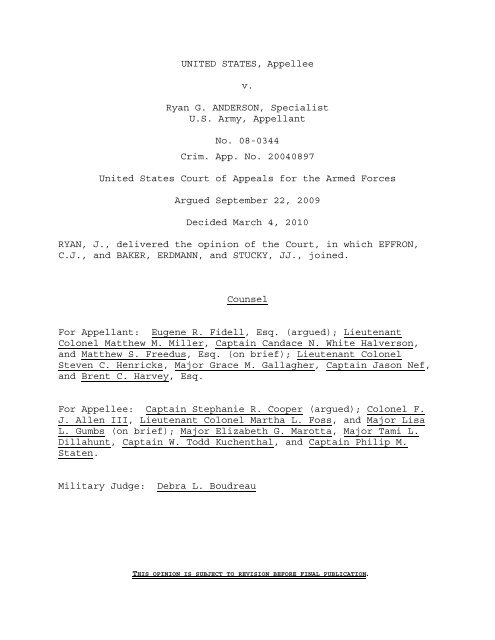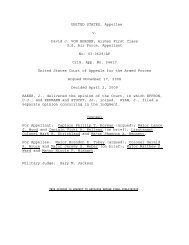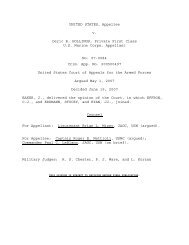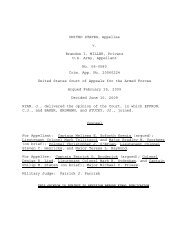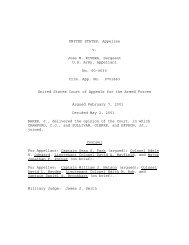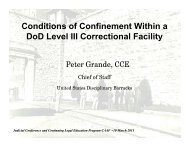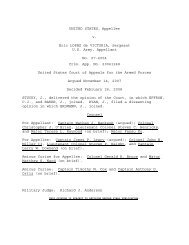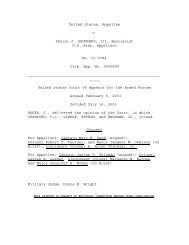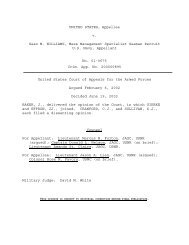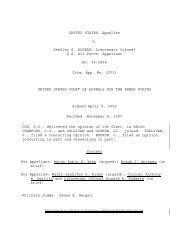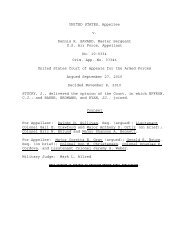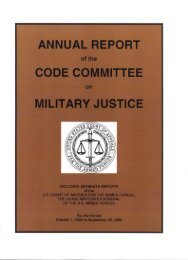United States v. Anderson - U.S. Court of Appeals for the Armed ...
United States v. Anderson - U.S. Court of Appeals for the Armed ...
United States v. Anderson - U.S. Court of Appeals for the Armed ...
You also want an ePaper? Increase the reach of your titles
YUMPU automatically turns print PDFs into web optimized ePapers that Google loves.
<strong>United</strong> <strong>States</strong> v. <strong>Anderson</strong>, No. 08-0344/ARJudge RYAN delivered <strong>the</strong> opinion <strong>of</strong> <strong>the</strong> <strong>Court</strong>.This case presents two questions: (1) whe<strong>the</strong>r Appellant’strial became fundamentally unfair where, after <strong>the</strong> militaryjudge denied Appellant’s request <strong>for</strong> a <strong>for</strong>ensic psychologistexpert witness, <strong>the</strong> Government presented such a witness duringits rebuttal case; and (2) whe<strong>the</strong>r <strong>the</strong> military judge erred infailing to dismiss charges under Articles 80, 104, and 134,Uni<strong>for</strong>m Code <strong>of</strong> Military Justice (UCMJ), 10 U.S.C. §§ 880, 904,934 (2000), because <strong>the</strong> charges were based on a singletransmission <strong>of</strong> in<strong>for</strong>mation to those Appellant believed to be<strong>the</strong> enemy. 1We first hold that we are convinced beyond areasonable doubt that <strong>the</strong> testimony <strong>of</strong> <strong>the</strong> Government’s witnesson rebuttal did not prejudice Appellant. Second, we hold that<strong>the</strong> challenged charges are not multiplictious, an unreasonablemultiplication <strong>of</strong> charges, or preempted. We <strong>the</strong>re<strong>for</strong>e affirm<strong>the</strong> decision <strong>of</strong> <strong>the</strong> lower court.1 Upon Appellant’s petition, we granted review <strong>of</strong> <strong>the</strong> followingissues:I. SHOULD THE MILITARY JUDGE HAVE DISMISSED CHARGEIII AS PREEMPTED, MULTIPLICIOUS, AND AN UNREASONABLEMULTIPLICATION OF CHARGES; AND THE ADDITIONAL CHARGEAS MULTIPLICIOUS WITH CHARGE I, SPECIFICATION 1, ANDAN UNREASONABLE MULTIPLICATION OF CHARGES WITH CHARGEI, SPECIFICATION 2?II. WAS APPELLANT AFFORDED A FAIR TRIAL EVEN THOUGHHIS REQUEST FOR A FORENSIC PSYCHIATRIST WAS DENIED ANDTHE GOVERNMENT THEREAFTER AVAILED ITSELF OF A FORENSICPSYCHIATRIST AND ATTACKED THE QUALIFICATIONS OF THEVERY EXPERT IT DID MAKE AVAILABLE TO THE DEFENSE?2
<strong>United</strong> <strong>States</strong> v. <strong>Anderson</strong>, No. 08-0344/ARI. FactsA general court-martial convicted Appellant, contrary tohis pleas, <strong>of</strong> one specification <strong>of</strong> attempting to giveintelligence to <strong>the</strong> enemy, two specifications <strong>of</strong> attempting tocommunicate with <strong>the</strong> enemy, one specification <strong>of</strong> attempting toaid <strong>the</strong> enemy, and one specification <strong>of</strong> wrongfully anddishonorably providing in<strong>for</strong>mation to military personnel whom hebelieved were terrorists, which was conduct prejudicial to goodorder and discipline and <strong>of</strong> a nature to bring discredit upon <strong>the</strong>armed <strong>for</strong>ces, in violation <strong>of</strong> Articles 80, 104, and 134, UCMJ.Appellant was sentenced to confinement <strong>for</strong> life with eligibility<strong>for</strong> parole and a dishonorable discharge. The sentence wasapproved by <strong>the</strong> convening authority and <strong>the</strong> <strong>United</strong> <strong>States</strong> Army<strong>Court</strong> <strong>of</strong> Criminal <strong>Appeals</strong> (CCA) affirmed in a per curiamopinion. <strong>United</strong> <strong>States</strong> v. <strong>Anderson</strong>, No. Army 20040897 (A. Ct.Crim. App. Jan. 31, 2008).The charges stem from actions that occurred be<strong>for</strong>eAppellant deployed with his Washington State National Guard unitto Iraq in <strong>the</strong> fall <strong>of</strong> 2004. Appellant began posting commentsand pictures on a website called “Brave Muslims.” On October 6,2003, Appellant posted a comment stating, “Soon, very soon, Iwill have an oppertunity [sic] to take my own end <strong>of</strong> <strong>the</strong>struggle against those who would oppress us, to <strong>the</strong> next level.Inshallah I shall be closer to some <strong>of</strong> you, and can enlist your3
<strong>United</strong> <strong>States</strong> v. <strong>Anderson</strong>, No. 08-0344/ARAt trial, Dr. Norris testified that he diagnosed Appellantwith Bipolar I Disorder, schizotypal and narcissistic features,and an unspecified personality disorder, but that none <strong>of</strong> <strong>the</strong>conditions prevented Appellant from knowing <strong>the</strong> differencebetween role-playing and reality or from separating fact fromfiction. The Government’s cross-examination <strong>of</strong> Dr. Norris wasquite limited. While <strong>the</strong> Government did draw attention to <strong>the</strong>fact that he was a clinical and not a <strong>for</strong>ensic psychologist --and <strong>the</strong>re<strong>for</strong>e not an expert in <strong>the</strong> interface between <strong>the</strong> law andpsychology -- nei<strong>the</strong>r <strong>the</strong> accuracy <strong>of</strong> Dr. Norris’s psychologicalevaluation nor his qualification to make such an evaluation wascalled into question. Appellant also presented testimony fromano<strong>the</strong>r expert, Dr. Russell Hicks, a staff psychiatrist at <strong>the</strong>Madigan Army Medical Center and Appellant’s treatingpsychiatrist, who testified that he had diagnosed Appellant withAsperger’s Syndrome and Bioplar I Disorder, which inhibitedAppellant’s ability to interact with o<strong>the</strong>rs but did not affecthis knowledge <strong>of</strong> <strong>the</strong> difference between right and wrong. Dr.Hicks based his opinion mainly on his observation <strong>of</strong> Appellantwhile in confinement and historical evidence <strong>of</strong> Appellant’sbehavior, and stated that he did not find evidencecontemporaneous to <strong>the</strong> crime helpful. On cross-examination, Dr.Hicks admitted that, while a practicing psychiatrist, he was not8
<strong>United</strong> <strong>States</strong> v. <strong>Anderson</strong>, No. 08-0344/ARII. Denial <strong>of</strong> Forensic PsychologistServicemembers are entitled to government-provided expertassistance if such assistance is necessary to <strong>the</strong>ir defense.<strong>United</strong> <strong>States</strong> v. Freeman, 65 M.J. 451, 458 (C.A.A.F. 2008). Thegovernment must provide <strong>the</strong> expert if <strong>the</strong> accused establishes:that a reasonable probability exists that (1) an expertwould be <strong>of</strong> assistance to <strong>the</strong> defense and (2) that denial<strong>of</strong> expert assistance would result in a fundamentally unfairtrial. To establish <strong>the</strong> first prong, <strong>the</strong> accused “mustshow (1) why <strong>the</strong> expert assistance is needed; (2) what <strong>the</strong>expert assistance would accomplish <strong>for</strong> <strong>the</strong> accused; and (3)why <strong>the</strong> defense counsel were unable to ga<strong>the</strong>r and present<strong>the</strong> evidence that <strong>the</strong> expert assistance would be able todevelop.”Id. (citations omitted). When <strong>the</strong> defense requests anonmilitary expert, <strong>the</strong> defense must provide an estimated cost<strong>of</strong> employment and illustrate why a military expert would be aninadequate substitute. While <strong>the</strong> military judge is not requiredto provide <strong>the</strong> particular expert requested, if <strong>the</strong> defense showsthat expert assistance is necessary an adequate substitute mustbe provided. <strong>United</strong> <strong>States</strong> v. Warner, 62 M.J. 114, 118(C.A.A.F. 2005). A military judge’s ruling regarding <strong>the</strong>appointment <strong>of</strong> a government-funded expert is reviewed <strong>for</strong> anabuse <strong>of</strong> discretion and will only be overturned if <strong>the</strong> findings<strong>of</strong> fact are clearly erroneous or <strong>the</strong> decision is influenced byan erroneous view <strong>of</strong> <strong>the</strong> law. See <strong>United</strong> <strong>States</strong> v. Lee, 64 M.J.213, 217 (C.A.A.F. 2006) (citing <strong>United</strong> <strong>States</strong> v. Gunkle, 55M.J. 26, 32 (C.A.A.F. 2001)).10
<strong>United</strong> <strong>States</strong> v. <strong>Anderson</strong>, No. 08-0344/ARThe decision to deny Appellant’s request <strong>for</strong> <strong>the</strong> expertassistance <strong>of</strong> Dr. Kennedy was not an abuse <strong>of</strong> discretion in <strong>the</strong>absence <strong>of</strong> any: (1) reason beyond a childhood diagnosis <strong>of</strong>Attention Deficit Disorder and <strong>the</strong> convening <strong>of</strong> an R.C.M. 706board to suggest that Appellant might lack <strong>the</strong> mental capacityto <strong>for</strong>m <strong>the</strong> specific intent required; or (2) assertion, after<strong>the</strong> subsequent request <strong>for</strong> <strong>the</strong> expert assistance <strong>of</strong> Dr. Norriswas granted, that Dr. Norris was inadequate. While <strong>the</strong>re arethree possible periods in which an abuse <strong>of</strong> discretion couldhave occurred (<strong>the</strong> initial denial <strong>of</strong> a <strong>for</strong>ensic psychologist by<strong>the</strong> convening authority, <strong>the</strong> affirmation <strong>of</strong> that denial by <strong>the</strong>military judge, or <strong>the</strong> appointment <strong>of</strong> Dr. Norris ra<strong>the</strong>r than <strong>the</strong>expert Appellant originally requested), Appellant’s argument isnot focused on <strong>the</strong>se actions. Instead, Appellant’s coreargument is that his court-martial was fundamentally unfairbecause <strong>the</strong> military judge, having rejected Appellant’s motionchallenging <strong>the</strong> convening authority’s denial <strong>of</strong> a governmentfunded<strong>for</strong>ensic psychologist, failed, after <strong>the</strong> Governmentsubsequently presented rebuttal testimony <strong>of</strong> a <strong>for</strong>ensicpsychiatrist, to revisit <strong>the</strong> earlier ruling or take some o<strong>the</strong>raction.A trial is fundamentally unfair where <strong>the</strong> government’sconduct is “so outrageous that due process principles wouldabsolutely bar <strong>the</strong> government from invoking judicial processes11
<strong>United</strong> <strong>States</strong> v. <strong>Anderson</strong>, No. 08-0344/ARto obtain a conviction.” <strong>United</strong> <strong>States</strong> v. Russell, 411 U.S.423, 431-32 (1973) (citation omitted). Appellant did not objectto <strong>the</strong> testimony or qualifications <strong>of</strong> <strong>the</strong> Government’s rebuttalexpert, and we <strong>the</strong>re<strong>for</strong>e review <strong>the</strong> military judge’s failure toact <strong>for</strong> plain error. See <strong>United</strong> <strong>States</strong> v. Powell, 49 M.J. 460,463-65 (C.A.A.F. 1998) (holding that failure to object at trialshould cause this <strong>Court</strong> to review solely <strong>for</strong> plain error, i.e.,error that is clear or obvious and materially prejudicial to anappellant’s substantial rights).As a threshold matter we note that Appellant does notargue, and it is not <strong>the</strong> law, that having expert type A <strong>for</strong>Appellant and expert type B <strong>for</strong> <strong>the</strong> Government on rebuttal isper se unfair. See Warner, 62 M.J. at 119 (requiring <strong>the</strong>defense expert to “have qualifications reasonably similar tothose <strong>of</strong> <strong>the</strong> Government’s”). Nor does Appellant detail how Dr.Norris was inadequate.In any event, we need not decide an issue <strong>of</strong> firstimpression, whe<strong>the</strong>r <strong>the</strong> military judge’s failure to stop <strong>the</strong>trial and appoint a <strong>for</strong>ensic psychologist to Appellant because<strong>the</strong> Government had one testify on rebuttal was error, let aloneplain error, because Appellant was not prejudiced by <strong>the</strong> limitedrebuttal testimony <strong>of</strong> <strong>the</strong> Government’s <strong>for</strong>ensic psychiatrist.See Article 59, UCMJ, 10 U.S.C. § 859 (2000); <strong>United</strong> <strong>States</strong> v.Farley, 60 M.J. 492, 493 (C.A.A.F. 2005) (“We need not decide12
<strong>United</strong> <strong>States</strong> v. <strong>Anderson</strong>, No. 08-0344/ARwhe<strong>the</strong>r <strong>the</strong>re was error, because any error was harmless.”).Because Appellant raises a due process argument, our test <strong>for</strong>prejudice must be whe<strong>the</strong>r <strong>the</strong> challenged action was harmlessbeyond a reasonable doubt. <strong>United</strong> <strong>States</strong> v. Buenaventura, 45M.J. 72, 79 (C.A.A.F. 1996); see Ake v. Oklahoma, 470 U.S. 68,86-87 (1985) (reversing and remanding case <strong>for</strong> a new trialbecause denial <strong>of</strong> expert assistance deprived defendant <strong>of</strong> dueprocess); <strong>United</strong> <strong>States</strong> v. Crews, 781 F.2d 826, 834 (10th Cir.1986) (finding prejudice where expert assistance wrongfullywithheld was indispensible <strong>for</strong> a fair trial).Dr. Malone’s testimony added little to <strong>the</strong> Government’scase and bolstered <strong>the</strong> testimony <strong>of</strong> Appellant’s experts. Ra<strong>the</strong>rthan attack <strong>the</strong> diagnoses <strong>of</strong> Appellant’s experts, Dr. Malonenoted that <strong>the</strong>re were legitimate reasons <strong>for</strong> <strong>the</strong> discrepancy indiagnosis among <strong>the</strong> two defense experts and that <strong>the</strong>irconclusions were entirely reasonable. The only discrepanciesbetween <strong>the</strong> testimony <strong>of</strong> Dr. Malone and ei<strong>the</strong>r defense expertconcerned <strong>the</strong> importance <strong>of</strong> certain evidence to a clinicaldiagnosis and <strong>the</strong> affect <strong>of</strong> Asperger’s Syndrome on cognitivefunctioning, and those discrepancies were between Dr. Malone andAppellant’s treating psychiatrist, not <strong>the</strong> court-appointedpsychologist. 3Because <strong>the</strong> Government’s rebuttal expert’s3 The evidence at issue was a videotape <strong>of</strong> Appellant meeting withtwo undercover agents on February 9, 2004. On <strong>the</strong> tape13
<strong>United</strong> <strong>States</strong> v. <strong>Anderson</strong>, No. 08-0344/ARtestimony merely confirmed <strong>the</strong> plausibility <strong>of</strong> Appellant’sexperts’ direct testimony, we are convinced beyond a reasonabledoubt that Appellant was not prejudiced by it.III. MultiplicityAppellant alleges that Charge III 4(simple disorder inviolation <strong>of</strong> Article 134, UCMJ) is multiplicious <strong>of</strong> Charge 1,Specifications 1 5(attempting to knowingly give intelligence toAppellant explained his intentions and personal beliefs,expressed a “considerable amount” <strong>of</strong> anti-American sentiment,and provided <strong>the</strong> undercover agents with <strong>the</strong> sensitivein<strong>for</strong>mation at issue in this case. Dr. Hicks, did not find <strong>the</strong>contemporaneous evidence <strong>of</strong> <strong>the</strong> crime crucial to his diagnosis,however, Dr. Malone testified that it was <strong>the</strong> best evidence onwhich to base a diagnosis.4 Charge III states:In that Specialist Ryan G. <strong>Anderson</strong>, also known as AmirAbdul Rashid, U.S. Army, did, on divers occasions, at ornear Fort Lewis, Yakima, Lakewood, Lynnwood, and Seattle,Washington, between, on or about 17 January 2004 and about10 February 2004, wrongfully and dishonorably provide:in<strong>for</strong>mation on U.S. Army troop movements, equipment,tactics, identification and weapon systems; methods andmeans <strong>of</strong> killing U.S. Army personnel and destroying U.S.Army weapon systems and equipment; and specificvulnerabilities <strong>of</strong> U.S. Army organizations, weapon systems,and equipment, to U.S. military personnel, whom <strong>the</strong> accusedthought were Tariq Hamdi and Mohammed, members <strong>of</strong> <strong>the</strong> alQaida terrorist network, such conduct being prejudicial togood order and discipline in <strong>the</strong> armed <strong>for</strong>ces, and <strong>of</strong> anature to bring discredit upon <strong>the</strong> armed <strong>for</strong>ces.5 Specification 1 <strong>of</strong> Charge I states:In that Specialist Ryan G. <strong>Anderson</strong>, also known as AmirAbdul Rashid, U.S. Army, did, on divers occasions, at ornear Fort Lewis, Yakima, Lakewood, Lynnwood, and Seattle,Washington, between, on or about 23 January 2004 and about14
<strong>United</strong> <strong>States</strong> v. <strong>Anderson</strong>, No. 08-0344/AR<strong>the</strong> enemy in violation <strong>of</strong> Articles 80 and 104, UCMJ) and 2 6(attempting to communicate with <strong>the</strong> enemy in violation <strong>of</strong>Articles 80 and 104, UCMJ), and that <strong>the</strong> Additional Charge 710 February 2004, attempt to, without proper authority,knowingly give intelligence to <strong>the</strong> enemy, by disclosingtrue in<strong>for</strong>mation to U.S. military personnel, whom <strong>the</strong>accused thought were Tariq Hamdi and Mohammed, members <strong>of</strong><strong>the</strong> al Qaida terrorist network, an enemy <strong>for</strong>ce, about:U.S. Army troop movements, equipment, tactics, and weaponsystems; methods and means <strong>of</strong> killing U.S. Army personneland destroying U.S. Army weapon systems and equipment; andspecific vulnerabilities <strong>of</strong> U.S. Army organizations, weaponsystems, and equipment.6 Specification 2 <strong>of</strong> Charge I states:In that Specialist Ryan G. <strong>Anderson</strong>, also known as AmirAbdul Rashid, U.S. Army, did, on divers occasions, at ornear Fort Lewis and Lynnwood, Washington, between, on orabout 17 January 2004 and about 22 January 2004, attemptto, without proper authority, knowingly communicate with<strong>the</strong> enemy, by oral, written, and electronic communicationto U.S. military personnel, whom he, <strong>the</strong> said SpecialistRyan G. <strong>Anderson</strong>, thought to be Tariq Hamdi, member <strong>of</strong> <strong>the</strong>al Qaida terrorist network, an enemy <strong>for</strong>ce, a communicationin words substantially as follows, to wit: I wish to meetwith you; I share your cause; I wish to continue contactthrough conversations and personal meetings.7 The Additional Charge states:In that Specialist Ryan G. <strong>Anderson</strong>, also known as AmirAbdul Rashid, U.S. Army, did, on divers occasions, at ornear Fort Lewis, Yakima, Lakewood, Lynnwood, and Seattle,Washington, between, on or about 23 January 2004 and about10 February 2004, attempt to, without property authority,knowingly communicate with <strong>the</strong> enemy, by oral, written andelectronic communication to U.S. military personnel, whomhe, <strong>the</strong> said Specialist Ryan G. <strong>Anderson</strong>, thought to beTariq Hamdi and Mohammed, members <strong>of</strong> <strong>the</strong> al Qaida terroristnetwork, an enemy <strong>for</strong>ce, a communication in wordssubstantially as follows, to wit: I wish to desert from<strong>the</strong> U.S. Army; I wish to defect from <strong>the</strong> <strong>United</strong> <strong>States</strong>; I15
<strong>United</strong> <strong>States</strong> v. <strong>Anderson</strong>, No. 08-0344/AR(attempting to communicate with <strong>the</strong> enemy in violation <strong>of</strong>Articles 80 and 104, UCMJ) is multiplicious <strong>of</strong> Charge 1,Specification 1 and an unreasonable multiplication <strong>of</strong> Charge 1,Specification 2. We disagree.We review multiplicity claims de novo. <strong>United</strong> <strong>States</strong> v.Roderick, 62 M.J. 425, 431 (C.A.A.F. 2006). “‘If a court,contrary to <strong>the</strong> intent <strong>of</strong> Congress, imposes multiple convictionsand punishments under different statutes <strong>for</strong> <strong>the</strong> same act orcourse <strong>of</strong> conduct,’ <strong>the</strong> court violates <strong>the</strong> Double JeopardyClause <strong>of</strong> <strong>the</strong> Constitution.” Id. (citations omitted) (emphasisin original). This <strong>Court</strong> “analyze[s] Congress’ intent using <strong>the</strong>separate elements test established in Blockburger v. <strong>United</strong><strong>States</strong>, 284 U.S. 299 (1932).” Id. at 432 (citations omitted).The applicable rule is that, where <strong>the</strong> same act ortransaction constitutes a violation <strong>of</strong> two distinctstatutory provisions, <strong>the</strong> test to be applied todetermine whe<strong>the</strong>r <strong>the</strong>re are two <strong>of</strong>fenses or only one,is whe<strong>the</strong>r each provision requires pro<strong>of</strong> <strong>of</strong> a factwhich <strong>the</strong> o<strong>the</strong>r does not.Blockburger, 284 U.S at 304.A facial comparison <strong>of</strong> <strong>the</strong> elements <strong>of</strong> <strong>the</strong> chargesAppellant claims are multiplictious demonstrates that each“requires pro<strong>of</strong> <strong>of</strong> a fact which <strong>the</strong> o<strong>the</strong>r does not.” Id.Article 134, UCMJ, requires a finding that (1) <strong>the</strong> accused didor failed to do certain acts, and (2) under <strong>the</strong> circumstances,wish to join al Qaida, train its members, and conductterrorist attacks.16
<strong>United</strong> <strong>States</strong> v. <strong>Anderson</strong>, No. 08-0344/AR<strong>the</strong> accused’s conduct was to <strong>the</strong> prejudice <strong>of</strong> good order anddiscipline in <strong>the</strong> armed <strong>for</strong>ces or was <strong>of</strong> a nature to bringdiscredit upon <strong>the</strong> armed <strong>for</strong>ces. Manual <strong>for</strong> <strong>Court</strong>s-Martial,<strong>United</strong> <strong>States</strong> pt. IV, para. 60.b. (2005 ed.) (MCM).Article80, UCMJ, however, also requires that <strong>the</strong> “certain acts” beovert and that <strong>the</strong> act (1) was done to commit a certain <strong>of</strong>fenseunder <strong>the</strong> code, (2) amounted to more than mere preparation, and(3) apparently tended to effect <strong>the</strong> commission <strong>of</strong> <strong>the</strong> intended<strong>of</strong>fense. MCM pt. IV, para. 4.b. Charge III and Charge I arenot multiplicious.Nor is <strong>the</strong> Additional Charge multiplictious with Charge I,Specification 1. While that specification concerns attempts togive intelligence to <strong>the</strong> enemy, <strong>the</strong> Additional Charge focuses onattempts to communicate with <strong>the</strong> enemy. Congress defined aiding<strong>the</strong> enemy as giving intelligence to or communicating with <strong>the</strong>enemy. See <strong>United</strong> <strong>States</strong> v. Dickenson, 6 C.M.A. 438, 450, 20C.M.R. 154, 166 (1955) (“As we read Article 104, none <strong>of</strong> <strong>the</strong>acts enumerated is conditioned upon, or restricted by, ano<strong>the</strong>r.Ra<strong>the</strong>r, <strong>the</strong> Article prohibits separate and distinct acts, each<strong>of</strong> which is sufficient by itself to constitute <strong>the</strong> <strong>of</strong>fense.”);compare MCM pt. IV, para. 28.b(4) (giving intelligence to <strong>the</strong>enemy), with MCM pt. IV, para. 28.b(5) (communicating with <strong>the</strong>enemy). Because each charge “requires pro<strong>of</strong> <strong>of</strong> a fact which <strong>the</strong>o<strong>the</strong>r does not,” <strong>the</strong> charges are not multiplicious.17
<strong>United</strong> <strong>States</strong> v. <strong>Anderson</strong>, No. 08-0344/ARIV. Unreasonable Multiplication <strong>of</strong> ChargesEven where charges are not multiplictious, “<strong>the</strong> prohibitionagainst unreasonable multiplication <strong>of</strong> charges has long providedcourts-martial and reviewing authorities with a traditionallegal standard –- reasonableness -- to address <strong>the</strong> consequences<strong>of</strong> an abuse <strong>of</strong> prosecutorial discretion in <strong>the</strong> context <strong>of</strong> <strong>the</strong>unique aspects <strong>of</strong> <strong>the</strong> military justice system.” <strong>United</strong> <strong>States</strong>v. Quiroz, 55 M.J. 334, 338 (C.A.A.F. 2001). Five factorsshould be considered when determining if multiple findings <strong>of</strong>guilt constitute an unreasonable multiplication <strong>of</strong> charges:(1) Did <strong>the</strong> accused object at trial that <strong>the</strong>re was anunreasonable multiplication <strong>of</strong> charges and/orspecifications?;(2) Is each charge and specification aimed atdistinctly separate criminal acts?;(3) Does <strong>the</strong> number <strong>of</strong> charges and specificationsmisrepresent or exaggerate <strong>the</strong> appellant’scriminality?;(4) Does <strong>the</strong> number <strong>of</strong> charges and specificationsunfairly increase <strong>the</strong> appellant’s punitive exposure?;(5) Is <strong>the</strong>re any evidence <strong>of</strong> prosecutorialoverreaching or abuse in <strong>the</strong> drafting <strong>of</strong> <strong>the</strong> charges?Id. (citation and quotation marks omitted).As we have previously held, <strong>the</strong> application <strong>of</strong> <strong>the</strong> Quirozfactors involves a reasonableness determination, much likesentence appropriateness, and is a matter well within <strong>the</strong>discretion <strong>of</strong> <strong>the</strong> CCA in <strong>the</strong> exercise <strong>of</strong> its Article 66(c),18
<strong>United</strong> <strong>States</strong> v. <strong>Anderson</strong>, No. 08-0344/ARUCMJ, 10 U.S.C. § 866 (2000), powers. Id. at 339; see <strong>United</strong><strong>States</strong> v. Sales, 22 M.J. 305, 307-08 (C.M.A. 1986); <strong>United</strong><strong>States</strong> v. Suzuki, 20 M.J. 248, 249 (C.M.A. 1985). In this case,<strong>the</strong> issue <strong>of</strong> unreasonable multiplication <strong>of</strong> charges was raisedto <strong>the</strong> CCA, af<strong>for</strong>ding <strong>the</strong> lower court <strong>the</strong> opportunity to awardrelief on this issue. No relief was awarded.We do not find that <strong>the</strong> CCA abused its discretion indeclining to find an abuse <strong>of</strong> prosecutorial discretion here.Appellant completed any number <strong>of</strong> independent actions that alonewould have been sufficient to support specifications in additionto <strong>the</strong> ones with which he was charged. While Appellant didobject at trial, his criminality was not exaggerated by <strong>the</strong>manner in which <strong>the</strong> conduct was charged; his punitive exposurewas not increased, because a conviction on any one <strong>of</strong> <strong>the</strong>Articles 80, UCMJ, <strong>of</strong>fenses had a maximum punishment <strong>of</strong> lifeconfinement; and <strong>the</strong> Government could easily have broken up <strong>the</strong>specifications as drafted into multiple different specificationsbased on specific contacts, e-mails, Internet postings, etc.While we do not have <strong>the</strong> benefit <strong>of</strong> <strong>the</strong> CCA’s reasoning becauseits disposition was summary, we presume that it undertook <strong>the</strong>correct analyses, cf. <strong>United</strong> <strong>States</strong> v. Robbins, 52 M.J. 455, 457(C.A.A.F. 2000) (“A military judge is assumed to know <strong>the</strong> lawand apply it correctly.”), and nothing about <strong>the</strong> lower court’simplicit determination that <strong>the</strong> charges were not unreasonably19
<strong>United</strong> <strong>States</strong> v. <strong>Anderson</strong>, No. 08-0344/ARmultiplicious invites this <strong>Court</strong> to reconsider its judgment.V. PreemptionFinally, Appellant suggests that Article 104, UCMJ,preempts <strong>the</strong> Article 134, UCMJ, <strong>of</strong>fenses in this case. By itstext, Article 134, UCMJ, applies to <strong>of</strong>fenses “not specificallymentioned in [Chapter 47 <strong>of</strong> Title 10, UCMJ].” The Presidentexpounded upon this language and placed <strong>the</strong> following limitationon Article 134, UCMJ, in <strong>the</strong> MCM:The preemption doctrine prohibits application <strong>of</strong>Article 134 to conduct covered by Articles 80 through132. For example, larceny is covered in Article 121,and if an element <strong>of</strong> that <strong>of</strong>fense is lacking -- <strong>for</strong>example, intent -- <strong>the</strong>re can be no larceny or larcenytype<strong>of</strong>fense, ei<strong>the</strong>r under Article 121 or, because <strong>of</strong>preemption, under Article 134. Article 134 cannot beused to create a new kind <strong>of</strong> larceny <strong>of</strong>fense, onewithout <strong>the</strong> required intent, where Congress hasalready set <strong>the</strong> minimum requirements <strong>for</strong> such an<strong>of</strong>fense in Article 121.MCM pt. IV, para. 60.c(5)(a). Although <strong>the</strong> effect <strong>of</strong> thislimitation seems clear, this <strong>Court</strong> has long placed an additionalrequirement on <strong>the</strong> application <strong>of</strong> <strong>the</strong> preemption doctrine thathas greatly restricted its applicability:[S]imply because <strong>the</strong> <strong>of</strong>fense charged under Article134, UCMJ, embraces all but one element <strong>of</strong> an <strong>of</strong>fenseunder ano<strong>the</strong>r article does not trigger operation <strong>of</strong><strong>the</strong> preemption doctrine. In addition, it must beshown that Congress intended <strong>the</strong> o<strong>the</strong>r punitivearticle to cover a class <strong>of</strong> <strong>of</strong>fenses in a completeway.<strong>United</strong> <strong>States</strong> v. Kick, 7 M.J. 82, 85 (C.M.A. 1979). Thus, wehave required Congress to indicate through direct legislative20
<strong>United</strong> <strong>States</strong> v. <strong>Anderson</strong>, No. 08-0344/ARlanguage or express legislative history that particular actionsor facts are limited to <strong>the</strong> express language <strong>of</strong> an enumeratedarticle, and may not be charged under Article 134, UCMJ. See,e.g., id. (“We do not agree that <strong>the</strong> legislative history <strong>of</strong>[Articles 118 and 119, UCMJ, 10 U.S.C. §§ 918, 919] indicates aclear intent to cover all homicides to <strong>the</strong> extent <strong>of</strong> eliminatingnegligent homicide as an <strong>of</strong>fense under Article 134, UCMJ.”);<strong>United</strong> <strong>States</strong> v. Taylor, 17 C.M.A. 595, 597, 38 C.M.R. 393, 395(1968) (“There is, <strong>the</strong>re<strong>for</strong>e, nothing in <strong>the</strong> legislativebackground <strong>of</strong> Article 115 to compel <strong>the</strong> conclusion that Congressintended to restrict criminal responsibility <strong>for</strong> self-injury tothose acts delineated in <strong>the</strong> Article.”); <strong>United</strong> <strong>States</strong> v.Taylor, 12 C.M.A. 44, 45-47, 30 C.M.R. 44, 45-47 (1960)(analyzing congressional intent regarding Articles 121 and 130,UCMJ, 10 U.S.C. §§ 921, 930, through statutory interpretation,comparison to o<strong>the</strong>r federal statutes, and review <strong>of</strong> legislativehistory). Appellant has not challenged <strong>the</strong> continued vitality<strong>of</strong> this <strong>Court</strong>’s preemption precedent, merely its application to<strong>the</strong> facts <strong>of</strong> this case.But <strong>the</strong> legislative history <strong>of</strong> Article 104, UCMJ, does notclearly indicate that Congress intended <strong>for</strong> <strong>of</strong>fenses similar tothose at issue to only be punishable under Article 104, UCMJ, to<strong>the</strong> exclusion <strong>of</strong> Article 134, UCMJ. Fur<strong>the</strong>rmore, while <strong>the</strong> twocharges in this case have parallel facts, as charged <strong>the</strong>y are21
<strong>United</strong> <strong>States</strong> v. <strong>Anderson</strong>, No. 08-0344/ARnone<strong>the</strong>less directed at distinct conduct. The Article 104,UCMJ, charge was directed at Appellant’s attempt to aid <strong>the</strong>enemy directly. The Article 134, UCMJ, charge was directedtowards <strong>the</strong> distribution <strong>of</strong> sensitive material to individualsnot authorized to receive it -- in this case CriminalInvestigation Command agents posing as <strong>the</strong> enemy, but <strong>the</strong>reasoning could just as easily be applied to <strong>the</strong> distribution <strong>of</strong>in<strong>for</strong>mation to individuals who are not necessarily <strong>the</strong> enemy,such as a newspaper reporter, or <strong>for</strong> that matter <strong>the</strong> privatecitizen who first encountered Appellant on <strong>the</strong> “Brave Muslim”website. Unlike Article 104, UCMJ, <strong>the</strong> general <strong>of</strong>fense ascharged prohibits <strong>the</strong> dissemination <strong>of</strong> <strong>the</strong> in<strong>for</strong>mationregardless <strong>of</strong> <strong>the</strong> intent behind that dissemination. If thisdistinction was not permissible in light <strong>of</strong> Article 104, UCMJ,Congress was free to clearly state that Article 104, UCMJ,supersedes Article 134, UCMJ, in this context. Appellant’spreemption argument is <strong>the</strong>re<strong>for</strong>e rejected.VI. DecisionThe decision <strong>of</strong> <strong>the</strong> <strong>United</strong> <strong>States</strong> Army <strong>Court</strong> <strong>of</strong> Criminal<strong>Appeals</strong> is affirmed.22


